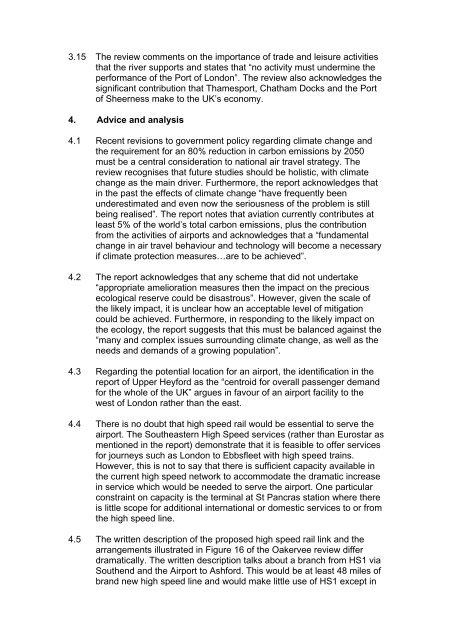1. Ecological objections - London
1. Ecological objections - London
1. Ecological objections - London
You also want an ePaper? Increase the reach of your titles
YUMPU automatically turns print PDFs into web optimized ePapers that Google loves.
3.15 The review comments on the importance of trade and leisure activities<br />
that the river supports and states that “no activity must undermine the<br />
performance of the Port of <strong>London</strong>”. The review also acknowledges the<br />
significant contribution that Thamesport, Chatham Docks and the Port<br />
of Sheerness make to the UK’s economy.<br />
4. Advice and analysis<br />
4.1 Recent revisions to government policy regarding climate change and<br />
the requirement for an 80% reduction in carbon emissions by 2050<br />
must be a central consideration to national air travel strategy. The<br />
review recognises that future studies should be holistic, with climate<br />
change as the main driver. Furthermore, the report acknowledges that<br />
in the past the effects of climate change “have frequently been<br />
underestimated and even now the seriousness of the problem is still<br />
being realised”. The report notes that aviation currently contributes at<br />
least 5% of the world’s total carbon emissions, plus the contribution<br />
from the activities of airports and acknowledges that a “fundamental<br />
change in air travel behaviour and technology will become a necessary<br />
if climate protection measures…are to be achieved”.<br />
4.2 The report acknowledges that any scheme that did not undertake<br />
“appropriate amelioration measures then the impact on the precious<br />
ecological reserve could be disastrous”. However, given the scale of<br />
the likely impact, it is unclear how an acceptable level of mitigation<br />
could be achieved. Furthermore, in responding to the likely impact on<br />
the ecology, the report suggests that this must be balanced against the<br />
“many and complex issues surrounding climate change, as well as the<br />
needs and demands of a growing population”.<br />
4.3 Regarding the potential location for an airport, the identification in the<br />
report of Upper Heyford as the “centroid for overall passenger demand<br />
for the whole of the UK” argues in favour of an airport facility to the<br />
west of <strong>London</strong> rather than the east.<br />
4.4 There is no doubt that high speed rail would be essential to serve the<br />
airport. The Southeastern High Speed services (rather than Eurostar as<br />
mentioned in the report) demonstrate that it is feasible to offer services<br />
for journeys such as <strong>London</strong> to Ebbsfleet with high speed trains.<br />
However, this is not to say that there is sufficient capacity available in<br />
the current high speed network to accommodate the dramatic increase<br />
in service which would be needed to serve the airport. One particular<br />
constraint on capacity is the terminal at St Pancras station where there<br />
is little scope for additional international or domestic services to or from<br />
the high speed line.<br />
4.5 The written description of the proposed high speed rail link and the<br />
arrangements illustrated in Figure 16 of the Oakervee review differ<br />
dramatically. The written description talks about a branch from HS1 via<br />
Southend and the Airport to Ashford. This would be at least 48 miles of<br />
brand new high speed line and would make little use of HS1 except in
















